ACL Reconstruction
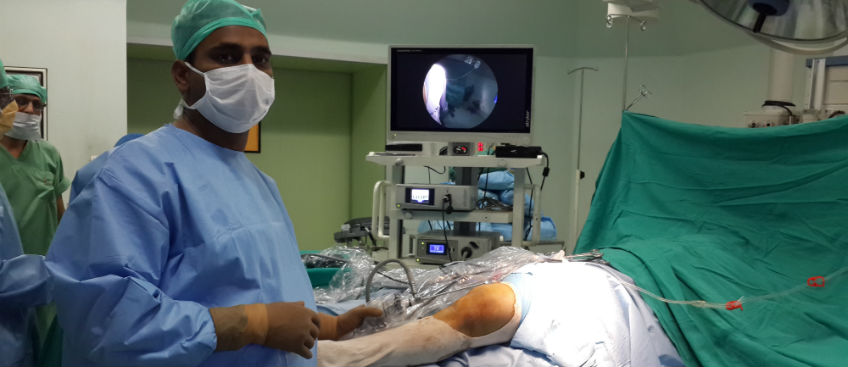
A knee Joint with important ligaments
The Anterior Cruciate Ligament is an important stabilizer of the knee. It consists of two different bundles in it. The ACL is located in the center of the knee joint and runs from the femur (thigh bone) to the tibia (shin bone), through the center of the knee. In this position, it functions to prevent a buckling type of instability of the knee.
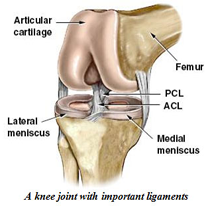
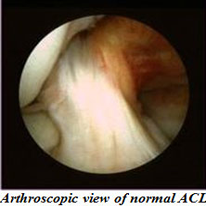
How Anterior Cruciate Ligament tear happens?
The ACL can be damaged by direct trauma, indirect twist or sporting activities mainly contact sports. Usually the tearing of the ACL occurs with a sudden direction change or when a deceleration force crosses the knee. The patient often feels or hears a popping sensation, has the rapid onset of swelling, and develops a buckling sensation in the knee when attempting to change direction.
What is the treatment of ACL tear?
The initial treatment of an acute ACL injury often includes ice, anti-inflammatory medication, and physical therapy which is directed at restoring the range of motion of the injured knee.
Depending upon the severity of injury treatment varies. Once the ligament is completely torn, it does not heal spontaneously. In case of incomplete tear wiyhout any symptoms of instability one can treat it in brace initially followed by physiotherapy. ACL reconstruction of the ligament is required if instability and history of repeated give way is present and it is confirmed on clinical and radiological (MRI) examination.
Who is a candidate for ACL Surgery?
People with high demand for sports such as soccer or basketball.
People with recurrent episodes of “giving way of knee”.
Benefits
Early return to activity and rapid functional recovery
Improves functional anatomy of knee thus preventing early damage to knee
Complications
As like other Surgeries, it is not 100% effective, but the success rate is 95% that is quite high. There are risks associated with the graft. These include failure of the graft, loosening of the graft, and a chance that the graft does not provide optimal stabilization of the knee following ACL surgery.
Infection though very uncommon with arthroscopic reconstruction is a possibility.
Stiffness of knee can occur.
Some residual instability is also reported in rare cases.
What is an ACL reconstruction?
Options for ACL reconstruction are:
Patellar tendon graft
It connects the patella (knee cap) to the tibia (shin bone), andits central third part can be used to reconstruct the ligament. The primary disadvantage is knee pain following the surgery.
Hamstring tendon
The hamstring muscle group (in the back of the thigh) can be harvested to take a graft. The advantage of the hamstring tendon is that there is less complaints of knee pain after surgery.
Most importantly, for the ACL surgery to have any chance of success, a significant effort is required post-operatively by the patient. Without adherence to a proper rehabilitation protocol, the ACL surgery failure rate increases dramatically!
What are those activities that i will not be able to do if I don’t go for surgery?
The ACL is required in pivoting, or making sudden lateral turn on a bend knee. So mainly contact sports like soccer and basketball requires such movements and you will have problem. One can jog, cycle, swim without a functional ACL.
What is the appropriate Timing of surgery
Surgery is usually not done unless and until a range of movement of at least 0-120 degrees is obtained in a knee that is quiet and non-inflamed. This can be any period from 3 weeks to 6 weeks from the injury. This decreases the risk of post-operative knee stiffness.
In some scenario like dislocated knee with multiple ligament injury that require repair, Early ACL reconstruction is done.
How do you reconstruct ACL?
Surgical treatment of the torn ACL usually involves an arthroscopic surgical reconstruction of the injured ligament. Although a number of different types of tissue have been utilized to reconstruct the ACL, the most common type of ACL reconstruction that we do involves harvesting the STG(Semitendinosus, Gracilis) tendon graft. After performing a diagnostic arthroscopic examination of the knee, STG(Semitendinosus, Gracilis) tendon graft is harvested. After harvesting the tissue, drill guides are used to place holes into the leg bone(Tibia) and thigh bone (Femur). Then the graft is pulled through the drill hole into the knee, in the same position as the original ACL. the graft is then held in place with bioabsorbable screws or metallic screws.
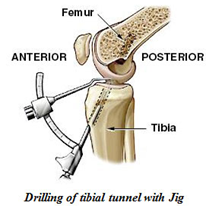
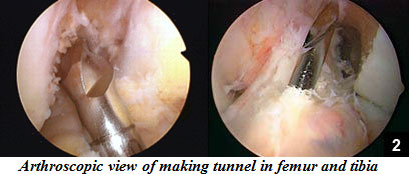
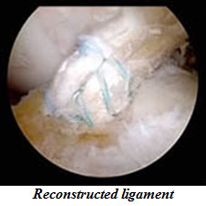
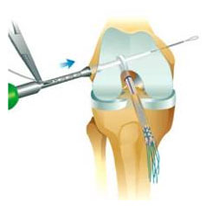
POST-OPERATIVE PERIOD
Partial weight bearing on the surgically treated leg by using crutches is started as soon as patient is comfortable after surgery.
Supervised physical therapy is started by the second to third day after surgery.
After 4-6 weeks patients will be doing home regime of sets of exercises as instructed by physiotherapist. One is advised not to indulge in any vigorous activity or conatact sports unless advised by Dr. Amit because it takes 6-9 months for reconstructed ligament to regain maximum strength.


